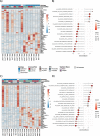Genomic and transcriptomic analysis of a diffuse pleural mesothelioma patient-derived xenograft library
- PMID: 36380343
- PMCID: PMC9667652
- DOI: 10.1186/s13073-022-01129-4
Genomic and transcriptomic analysis of a diffuse pleural mesothelioma patient-derived xenograft library
Abstract
Background: Diffuse pleural mesothelioma (DPM) is an aggressive malignancy that, despite recent treatment advances, has unacceptably poor outcomes. Therapeutic research in DPM is inhibited by a paucity of preclinical models that faithfully recapitulate the human disease.
Methods: We established 22 patient-derived xenografts (PDX) from 22 patients with DPM and performed multi-omic analyses to deconvolute the mutational landscapes, global expression profiles, and molecular subtypes of these PDX models and compared features to those of the matched primary patient tumors. Targeted next-generation sequencing (NGS; MSK-IMPACT), immunohistochemistry, and histologic subtyping were performed on all available samples. RNA sequencing was performed on all available PDX samples. Clinical outcomes and treatment history were annotated for all patients. Platinum-doublet progression-free survival (PFS) was determined from the start of chemotherapy until radiographic/clinical progression and grouped into < or ≥ 6 months.
Results: PDX models were established from both treatment naïve and previously treated samples and were noted to closely resemble the histology, genomic landscape, and proteomic profiles of the parent tumor. After establishing the validity of the models, transcriptomic analyses demonstrated overexpression in WNT/β-catenin, hedgehog, and TGF-β signaling and a consistent suppression of immune-related signaling in PDXs derived from patients with worse clinical outcomes.
Conclusions: These data demonstrate that DPM PDX models closely resemble the genotype and phenotype of parental tumors, and identify pathways altered in DPM for future exploration in preclinical studies.
© 2022. The Author(s).
Conflict of interest statement
MDO has consulted regarding oncology drug development with Novartis, Jazz, and PharmaMar. MDO has received honorarium from Targeted Oncology, OncLive, and the American Society for Radiation Oncology.
AR has consulted regarding oncology drug development with AstraZeneca, Merck, Boehringer Ingelheim, and Cybrexa. AR has received honorarium from MoreHealth and ResearchToPractice. AR serves on the scientific advisory boards of Merck. AR has received grants from Varian Medical Systems, Boehringer Ingelheim, Pfizer, AstraZeneca, and Merck.
PSA has intellectual property and licensing royalties on mesothelin-targeted CAR T cell therapy, serves on scientific boards of Atara Bio, Bayer, BioArdis, Carisma therapeutics, Immugene, ImmPACT bio; consulted for Atara, Bayer; and has received research support from Atara Bio
MGZ has received consulting fees from Ikena, Takeda, GlaxoSmithKline, Aldeyra Therapeutics, and Novocure and honoraria for CME content from PER, Medscape, Research to Practice, Medical Learning Institute and OncLive. Memorial Sloan Kettering receives research funding from the Department of Defense, the National Institutes of Health, Precog, GlaxoSmithKline, Epizyme, Polaris, Sellas Life Sciences, Bristol Myers Squibb, Millenium/Takeda, Curis, and Atara for research conducted by MGZ. MGZ serves as Chair of the Board of Directors of the Mesothelioma Applied Research Foundation, an uncompensated position.
CMR has consulted regarding oncology drug development with Amgen, Daiichi Sankyo, Genentech/Roche, Ipsen, Jazz, Merck, Pfizer, Syros, and Vavotek. CMR serves on the scientific advisory boards of Bridge Medicines, Earli, and Harpoon Therapeutics.
TS has research funding from Jazz Pharmaceuticals.
The remaining authors declare that they have no competing interests.
Figures





References
-
- Noone A, Howlander N, Krapcho M, et al. SEER Cancer Statistics Vol. based on November 2017 (SEER, 2017). https://seer.cancer.gov/archive/csr/1975_2017/.
-
- Tsao AS, et al. Current and future management of malignant mesothelioma: a consensus report from the National Cancer Institute Thoracic Malignancy Steering Committee, International Association for the Study of Lung Cancer, and Mesothelioma Applied Research Foundation. J Thorac Oncol. 2018;13:1655–1667. doi: 10.1016/j.jtho.2018.08.2036. - DOI - PubMed
Publication types
MeSH terms
Grants and funding
LinkOut - more resources
Full Text Sources
Medical

